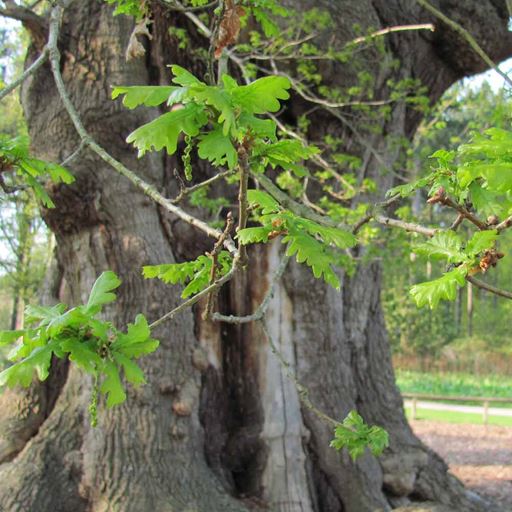Celebrating the ancient oak
-
Date
Fri 28 Aug 20

In his new book, Dr James Canton, from the Department of Literature, Film, and Theatre Studies, explores our unique relationship with the oak tree.
Recently serialised as Book of the Week by Radio 4, The Oak Papers has been described as “a profound meditation on the human need for connection with nature”.
Dr Canton spent many hours observing the ecosystem of the Honywood Oak and explored oak lore in the British Library. Here he explains what inspired him and why he believes the oak tree holds such a special place in British hearts.
What inspired you to write this book?
The Oak Papers is about an amazing individual tree – the Honywood Oak on Marks Hall Estate in Coggeshall. It is over 800 years old.
Trees operate at a different pace to humans. When the Honywood Oak was a mere sapling, the Magna Carta was signed, 400 years on Parliamentarian soldiers gathered beneath its boughs before marching to join the siege of Colchester in 1648.
Seeing ancient oaks in such terms makes us realise their significance as figures on the landscape. That expanse of ‘nature time’ is what makes ancient oaks such important homes for hundreds and thousands of creatures who rely on the specific environments which such trees offer. The Forest Silver-stiletto fly for instance lives at the very centre of aged oak trees. It is only after hundreds of years that such habitats develop. Every ancient oak that is cut down is the loss of an environment that cannot be replaced.
I was inspired to write The Oak Papers by learning more and more of the ways of oak trees and the wealth of cultural and historical links between humans and oaks that have been in existence since prehistoric times. We have always relied on oak trees. Today, we are seeing the powerful effects which being by oaks, being in nature, can have on our own well-being.
Spending time beside the Honywood Oak has taught me much – one of the most important lessons was that peace and calm can be found sat by or within an oak tree.
Why does the oak tree hold such a special place in the British psyche?
It’s a complex matter. In The Oak Papers I explain that the oak tree has long served as a symbol of national identity and that the expression ‘hearts of oak’ exemplifies a natural state Britain has seen as evocative of its own citizens. I also explore the story of how, following his defeat in the Battle of Worcester, Charles II was on the run and was apparently saved by hiding in an oak tree at Boscobel House in Shropshire.
In the naval history too, ‘hearts of oak’ was employed as a term not only for the ships that secured the empire but the Britons who sailed upon them.
But Britain isn’t alone in thinking it has a special relationship with the oak. Germany also views its national identity as closely associated with the tree and the oak leaf/acorn symbolism, so does Latvia. In fact there are countries all across the globe which do. Wherever oaks grow, people feel a close tie to them.
![Dr James Canton, smiling and wearing a dark blue sweater]() "Anyone who has ever climbed an oak, or hugged one, or merely touched the skin of one will know the connection between human and oak trees."
"Anyone who has ever climbed an oak, or hugged one, or merely touched the skin of one will know the connection between human and oak trees."
Has our relationship with the tree changed?
In many ways it has, as we no longer rely on oaks to provide us with wood for our homes or fuel for our fires, yet I do maintain that in ways we do not fully understand oaks are good for us.
The evidence is that the earliest farmers, 6,000 years ago or so, relied on acorns to make their bread in years of famine or when their crops failed. Something of that reliance on oaks still lingers on within us today.
We might not physically need oaks and yet we feel better when we go to green spaces and when we are in woodlands – this has been proven by scientists such as my colleague Dr Mike Rogerson, from the School of Sport, Rehabilitation and Exercise Sciences.
What does it tell us about our relationship with trees and nature more widely?
There are many aspects of other trees that are equally important. Yews are long associated with human activity and worship. All trees have their own particular aspects which humans would do well to know and recognise.
Who is your book for?
The Oak Papers is very much for a general reader. Anyone who has ever climbed an oak, or hugged one, or merely touched the skin of one will know the connection between humans and oak trees.
Hopefully, we can start to recognise that cutting down ancient oaks is not something that should happen lightly and that we must protect and care for the remaining aged oaks that live on these lands.
The Oak Papers research was part-funded by the Arts and Humanities Research Council. It is published by Canongate.
)
.jpg?mh=500&mw=500&hash=6568B6C9CCF5290A596BEF6678B6AD0E)



